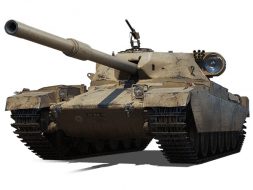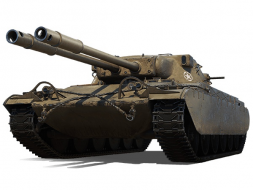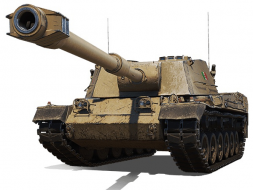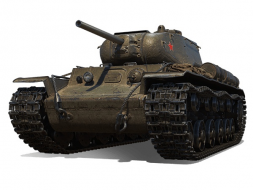Расскажите чего вам не хватает на нашем сайте
Обратная связьChanges of premium tanks in the test update 1.18 World of Tanks
All the tanks have received minor changes, but are not yet ready for a full release. However, all of them will be released tentatively in the period from 1.18 to the next patch.
FV4201 Chieftain Proto (UK, TT-9, premium)
Changes relative to base 1.17.1.
General:
- Tank strength repair cost: from 19,500 to 18,000
Firepower:
- Spread from movement (max): from 0.17 (5.95) to 0.22 (7.70)
- Scatter from chassis rotation (max): from 0.17 (5.32) to 0.22 (6.20)
- Scope rotation spread (max): from 0.08 (2.67) to 0.13 (3.66)
- Sight translation rate: from 33.38 to 28.16
Survivability:
- Strength / HP of the tank: from 1,950 to 1,800
Mobility:
- Chassis rotation speed: from 31.29 to 28.16
Surveillance:
- Surveillance: c 400 to 390
TS-54 (USA, TT-8, prime, double-barreled gun mechanics)
Changes relative to base 1.17.1/
General:
- Role in combat: c Heavy tank breakout tank to Heavy tank versatile
- Cost of tank strength repair: from 7 000 to 8 000
Firepower:
- Firepower: From 3.36 to 2.88
- Range at 100 m: 0.42 to 0.40
Survivability:
- Strength / HP of the tank: from 1,400 to 1,600
Mobility:
- Engine power: from 570 to 650
- Specific Power: from 11.40 to 13.00
SMV CC-64 Vipera (Italy, PT-8, premium)
Changes relative to base 1.17.1.
General:
- Added historical reference:
Italian PT-SAU with turret of limited turning sector. Work on the project was carried out in the second half of the 1960s as part of cooperation with Western European Union countries in the development of new armored vehicles. The work was curtailed at the design stage. - Cost of tank strength repair: from 8,400 to 7,800
Firepower:
- Movement dispersion (max): from 0.25 (8.00) to 0.25 (7.50)
Survivability:
- Strength / HP of the tank: from 1,400 to 1,300
Mobility:
- Max forward speed: from 32 to 30
KV-1C with MH (USSR, TT-5, gift box, magazine for 6 shells with recharging)
Changes relative to the first iteration of the supertest.
General:
- Added historical background:
Beginning in 1941, G. V. Barabash, a teacher at the Red Army's Military Academy of Mechanization and Motorization, developed at least 5 variants of mechanized loading for Soviet combat vehicles. The most perfect scheme of shells feeding, providing 12-18 shots per minute, was suggested in July 1943. The basis for the development was KV-1C. The tank received a modified turret with two hatches in the wall for loading shells and a developed aft niche for ammunition. Also the shells were in mechanized stowage on the floor of the fighting compartment, under the gun. Since the mechanism did not involve full automation of the process, the crew kept a loader. Representatives of the SABTU of the Red Army, not trying to carry out experiments, opposed the engineer's proposals, and by early 1944 the mechanism for 76.2 mm guns had already lost relevance. After the war G.V. Barabash managed to obtain copyright certificates for several of his proposals. Probably later they were considered by the design teams which designed the loading mechanisms for Soviet tanks of 1950-1960s. - A detailed description of the tank has been added:
V level Soviet heavy tank. The machine is the only one at its level equipped with a multiple-round recharge mechanism. The unique feature allows you to show incredible efficiency when you need to quickly inflict damage on the enemy or support fire allies. - Added a short description of the tank:
Reverse recharge mechanism, good rate of fire
Firepower:
- Ammunition: c 100 to 90
Comments


 ждём ****** баланса на 5 и 3 лвл.Опять вымышленное гуано,описание с балды придумали(опять же),все ттх вымышленные ОПЯТЬ ЖЕ.Ребята,не говорите сначала что эта игра ИСТОРИЧНАЯ,ВЫПУСКАЯ НЕИСТОРИЧНУЮ ШНЯГУ.
ждём ****** баланса на 5 и 3 лвл.Опять вымышленное гуано,описание с балды придумали(опять же),все ттх вымышленные ОПЯТЬ ЖЕ.Ребята,не говорите сначала что эта игра ИСТОРИЧНАЯ,ВЫПУСКАЯ НЕИСТОРИЧНУЮ ШНЯГУ.

Log In
Read more
The main composition of the event store for the 12th anniversary of World of Tanks
You know what to save for.
Bonuses and discounts for the 12th anniversary of World of Tanks
While you're collecting holiday coins for your daily...
World of Tanks turns 12: details of the event
This month World of Tanks celebrates its 12th anniversary!...
Latest news
Patchnote of the third general test update 1.18.1 in World of Tanks
List of changes to OT3 1.18.1 compared to OT2 1.18.1.
The AMX M4 mle. 54 will get a TTH weakening in World of Tanks patch 1.18.1
As said, the main imbue of the last patch was not the...
Onslaught 2022: Rating system and rewards in World of Tanks
The Gryphon season will run from October 12, 11:00...
Календарь новостей
| Mo | Tu | We | Th | Fr | Sa | Su |
|---|---|---|---|---|---|---|
| 1 | 2 | 3 | 4 | 5 | ||
| 6 | 7 | 8 | 9 | 10 | 11 | 12 |
| 13 | 14 | 15 | 16 | 17 | 18 | 19 |
| 20 | 21 | 22 | 23 | 24 | 25 | 26 |
| 27 | 28 | 29 | 30 | 31 |



